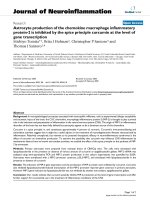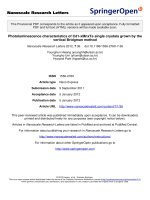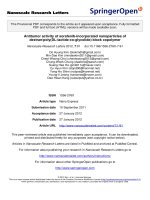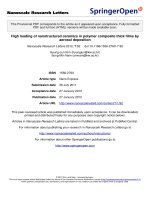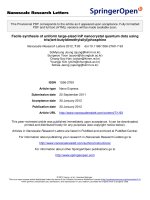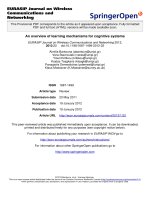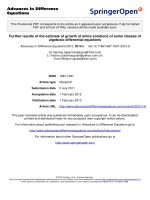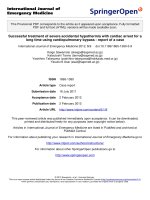Báo cáo toán học: " Semi-industrial production of methane from textile wastewaters" pdf
Bạn đang xem bản rút gọn của tài liệu. Xem và tải ngay bản đầy đủ của tài liệu tại đây (396.96 KB, 18 trang )
This Provisional PDF corresponds to the article as it appeared upon acceptance. Fully formatted
PDF and full text (HTML) versions will be made available soon.
Semi-industrial production of methane from textile wastewaters
Energy, Sustainability and Society 2012, 2:1 doi:10.1186/2192-0567-2-1
Klaus Opwis ()
Thomas Mayer-Gall ()
Jochen S Gutmann ()
Christoph Dammer ()
Tanja Titscher ()
Anna Nickisch-Hartfiel ()
Oliver Gruen ()
Christoph Spurk ()
Christine Schloderer ()
Axel Koeppe ()
Christian Doerfler ()
Herbert Bachus ()
ISSN 2192-0567
Article type Original
Submission date 11 October 2011
Acceptance date 17 January 2012
Publication date 17 January 2012
Article URL />This peer-reviewed article was published immediately upon acceptance. It can be downloaded,
printed and distributed freely for any purposes (see copyright notice below).
For information about publishing your research in Energy, Sustainability and Society go to
/>For information about other SpringerOpen publications go to
Energy, Sustainability and
Society
© 2012 Opwis et al. ; licensee Springer.
This is an open access article distributed under the terms of the Creative Commons Attribution License ( />which permits unrestricted use, distribution, and reproduction in any medium, provided the original work is properly cited.
1
Semi-industrial production of methane from textile wastewaters
Klaus Opwis*
1
, Thomas Mayer-Gall
1
, Jochen S Gutmann
1
, Christoph Dammer
2
, Tanja
Titscher
2
, Anna Nickisch-Hartfiel
2
, Oliver Grün
3
, Christoph Spurk
3
, Christine Schloderer
4
,
Axel Köppe
4
, Christian Dörfler
5
, and Herbert Bachus
5
1
Deutsches Textilforschungszentrum Nord-West e.V., Adlerstraße 1, Krefeld, 47798,
Germany
2
Hochschule Niederrhein, Reinarzstraße 49, Krefeld, 47805, Germany
3
OeKOBiT GmbH, Jean-Monnet-Straße 12, Foehren, 54343, Germany
4
Textilveredlung an der Wiese, Schopfheimer Straße 27, Loerrach, 79541, Germany
5
CHT R. Beitlich GmbH, Bismarckstraße 102, Tuebingen, 72072, Germany
*Corresponding author:
Email addresses:
KO:
TM-G:
JG:
CD:
TT:
AN-H:
OG:
CS:
CS:
AK:
CD:
HB:
Abstract
Background: The enzymatic desizing of starch-sized cotton fabrics leads to wastewaters with
an extremely high chemical oxygen demand due to its high sugar content. Nowadays, these
liquors are still disposed without use, resulting in a questionable ecological pollution and high
emission charges for cotton finishing manufacturers.
2
Methods: In this paper, an innovative technology for the production of energy from textile
wastewaters from cotton desizing was developed. Such desizing liquors were fermented by
methane-producing microbes to biogas. For this purpose, a semi-industrial plant with a total
volume of more than 500 L was developed and employed over a period of several weeks.
Results: The robust and trouble-free system produces high amounts of biogas accompanied
by a significant reduction of the COD of more than 85%. With regard to growing standards
and costs for wastewater treatment and disposal, the new process can be an attractive
alternative for textile finishing enterprises in wastewater management, combining economic
and ecological benefits.
Conclusion: Moreover, the production of biogas from textile wastewaters can help to
overcome the global energy gap within the next decades, especially with respect to the huge
dimension of cotton pretreatment and, therefore, huge desizing activities worldwide.
Keywords: cotton pretreatment; desizing; wastewater; COD; methane; biogas.
Background
In the manufacturing of cotton yarns to textile fabrics, so-called sizing agents are needed in
order to protect the warp threads against huge mechanical stress in the weaving process. Apart
from synthetic agents, starch is still the most important sizing agent, and more than 1 million
tons of starch are used per year worldwide. After weaving, the starch has to be removed from
the raw cotton fabric to avoid impairments in the following finishing steps such as scouring,
bleaching, and dyeing. Since many decades, the desizing of starch-sized cotton has been
conducted by the use of α-amylases, which are able to hydrolyze the water-insoluble starch to
water-soluble oligosaccharides under moderate conditions compared to the harsh oxidative
procedures [1, 2]. However, the enzymatic desizing procedure leads to wastewaters with very
high sugar content and therefore, an extremely high chemical oxygen demand [COD].
Nowadays, these liquors are still disposed without use, resulting in a questionable ecological
pollution and high emission charges for cotton finishing manufacturers.
Despite highly scientific efforts, up to now, no economic strategy for the recycling of these
ecological critical wastewaters exists. Several works, for instance, foresee the enzymatic
oxidation of these sugars to gluconic acid and hydrogen peroxide using oxidoreductases such
as glucose oxidases and peroxidases with the goal to use them in cotton bleaching steps
(Figure 1, left) [3-7]. However, because of the high costs of enzymes and the insufficient
bleaching grade, these strategies failed. Another approach aims at the transformation of the
sugars to valuable cyclodextrins by applying cyclodextrin glycosyl transferases, but this
process is still under development and the commercial relevance is not clear at the moment
(Figure 1, middle) [8].
In principle, the sugars from desizing are ideal substrates for the biological fermentation to
biogas. The biogas process itself is well known, using various microbes for the step-wise
transformation of native biomass such as carbohydrates, proteins, and fats to methane.
Besides energy from wind, water, and sun power, the generation of energy from organic
materials - especially undissolved solid residuals from agriculture - plays the most important
role in the production of regenerative energy [9, 10]. Apart from the obvious wastes from
3
domestic homes and especially economic plants such as corn, wheat, rice, and all kinds of
vegetables and fruits, various industry-specific recycling strategies have been developed to
generate an added value in the production chain and to minimize pollutions. This includes the
biogas generation from wastewaters coming from, e.g., food, chemical, and pharmaceutical
industries [11-17]. In the textile industry, and especially here in the cotton manufacturing,
various scientific groups are investigating the biogas or bio-ethanol production starting from
solid residuals such as willow dusts or fiber wastes with a subsequent enzymatic or chemical
hydrolysis of the cellulosic material [18-21].
Here, the pre-hydrolyzed saccharides coming from the enzymatic desizing step in cotton
pretreatment are already in the liquefied state and can be applied directly to anaerobic
fermentation. In our previous work, we described this process (Figure 1, right), dealing with
the biological transformation of such sugar-containing wastewaters from textile desizing
liquors to methane-containing biogas [22]. After showing the principle feasibility of the new
innovative strategy, here, the change to more industrial relevant continuous reactor conditions
and the upscaling is described and completed by an economic and ecological outlook of the
overall process.
Especially in these days of climate change, where huge polluting catastrophes such as the oil
disaster in the gulf of Mexico (2010) and the nuclear accident in Japan (2011) are querying
more and more the energy supply by fossil fuels and nuclear power, alternatives from
renewable resources, wind, water, and solar energies, are essential to overcome the energy
gap within the next decades. Therefore, the present investigation is another contribution to
make this world cleaner and safer.
Methods
Liquid substrate
Industrial liquors from enzymatic desizing processes were delivered by Textilveredlung an
der Wiese (Loerrach, Germany). Within an industrial washing machine (schematically shown
in Figure 2), the desizing liquors were squeezed from the wetted cotton material with a high
pressure squeezer. A sample drawing was carried out in the first washing compartment of the
industrial washing machine, where the highest carbohydrate concentration was expected. The
industrial desizing liquors were directly taken as substrates for the anaerobic biogas
generation without any additives. To characterize the initial desizing liquors, various
analytical procedures were carried out (see ‘Analytics’ section).
Lab-scale reactor
First, the continuous anaerobic fermentation of the desizing liquors was carried out in a lab-
scale biogas reactor with biomass recirculation at 38°C schematically shown in Figure 3. The
sugar-containing medium was supplied in an upstream mixing chamber, where the pH value
was adjusted to 7.2. Adequate microbes for the biological transformation were taken from an
agricultural biogas plant (Wassenberg, Germany). The total volume of the system accounts
4.8 L. Within this reactor, the methane content of the produced biogas was determined by an
infrared BCP-CH4 (BlueSens GBR, Herten, Germany).
Semi-industrial biogas plant
By upscaling the reactor to a total volume of 550 L (main fermenter 430 L) the continuous
semi-industrial fermentation was conducted in a system schematically illustrated in Figure 4.
4
The system is able to measure several parameters such as temperature, pressure, pH value,
tank filling height, volume flow, generated gas amount, and chemical gas composition online
and simultaneously.
Analytics
The COD, the total organic carbon [TOC], and the total nitrogen of the desizing liquors were
measured using the testing kits HT-COD LCK 014, TOC LCK 387, and LatoN LCK 338
(HACH LANGE GMBH, Duesseldorf, Germany), respectively. The element contents of the
initial desizing liquor were determined according to DIN EN 13346. About 100 mL of
desizing liquor was liberated from water by heating and followed by drying for 6 h at 80°C.
About 300 mg of the waterless residue was treated with 6.0 mL of concentrated HNO
3
(65%)
and 2.0 mL of concentrated HCl (37%) digested in a microwave digester (MARSXpress,
CEM, Kamp-Lintfort, Germany) at 180°C. The completely digested samples as a clear
solution were transferred to a 25-mL volumetric flask and subsequently diluted with distilled
water. The samples thus prepared were analyzed using an inductively coupled plasma optical
emission spectrometer [ICP/OES] (720-ES, Varian Medical Systems GmbH, Darmstadt,
Germany) to determine the element concentrations.
Toxicological studies (TTC test)
The dehydrogenase activities of living microorganisms reduce the redox indicators such as the
colorless triphenyl tetrazolium chloride [TTC] to red formazan (absorption maximum at 480
nm). Therefore, 4.5 mL of desizing liquor (i.e., 4.5 mL of 2% aqueous glucose solution as a
blank test) was inoculated with 4.5 mL of bacterial population from the methane reactor and
1.0 mL TTC (51 mg/mL). After an incubation time of 2, 4, and 24 h, the color generation was
measured. The red color indicates living cells, i.e., a nontoxic behavior of the medium.
Results and discussion
The chemical and biological characterizations of the squeezed desizing liquors from the
typical enzymatic desizing process in cotton pretreatment evidence the ideal properties for a
biological anaerobic fermentation. The high sugar load coming from starch leads to an
average COD of 40 g/L and a TOC of 13.2 g/L. Moreover, the liquors contain 0.3 g/L
nitrogen and 65 mg/L phosphorus which assist the growth of the biogas-forming microbes.
The pH value is in the range of moderate 6.0, and no toxic metals were found when
conducting the ICP/OES study. In addition, the absence of toxic components has been proven
by toxicological studies using the TTC test. Within this test, the dehydrogenase activity of
living microorganisms reduces the colorless TTC to red formazan (Figure 5).
Figure 6 presents the results of the TTC test. The red color of the generated formazan can
clearly be seen, indicating living cells in the presence of the textile desizing liquors. No hint
was observed that the desizing liquors inhibit or even kill the bacteria. In total, the present
properties allow a direct use of the liquors without any subsequent treatment or accumulation
- apart from a slight raise of the pH value to 7.2 using caustic soda to reach optimal
fermentation conditions.
The studies on biogas production have been started with a static gas emission experiment
carried out with the desizing liquor in the presence of the seeding sludge from the agricultural
5
biogas plant (Wassenberg, Germany). Figure 7 shows the corrected time-dependent gas
emission of the desizing liquor over a period of 524 h.
The outgassing starts rapidly with a strong generation of biogas within the first 120 h, where
approximately two thirds of the total biogas amount was accumulated. Afterwards, the curve
flattened significantly, and after 360 to 400 h (ca. 15 to 16 days), the biogas generation was
finished to the greatest possible extent. The experiment was interrupted after 524 h. At this
moment, 27 m
3
of biogas was generated per cubic meter of textile desizing liquor. The
methane content within the produced biogas amounted to 51%.
Based on these results, the feed supply within the lab-scale reactor was adjusted to 0.22 mL of
the desizing liquor per minute, which is corresponding to an absolute dwell time of again
approximately 15 days (reactor volume = 4.8 L). Under these continuous fermentation
conditions, an effective biogas production was observed with a COD reduction in the range of
50% to 75% over a period of 72 days (see Figure 8, lab-scale reactor).
The hydraulic design of the semi-industrial plant was aligned with the results from the lab-
scale reactor and the static gas emission experiments. The measured dwell time (15 to 16
days) was supplemented by a conservative overhead of 50%, leading to a maximal expected
dwell time in the new reactor of 24 days. The main fermenter has an absolute volume of 430
L, and therefore, a needed input of 18 L of desizing liquor per day resulted in a calculated
biogas production of 486 L/day.
After implementing the continuous fermentation process, a constant biogas production was
observed. Table 1 shows the average chemical composition of the biogas with a methane
content of almost 60 vol.%.
Moreover, a high reduction of the COD within the drain outlet was detected. Figure 8
demonstrates a relative decrease of COD over the regarded period of 72 days. Compared to
the lab-scale reactor, the semi-industrial plant exhibits a further improvement of the
degradation performance to average levels of more than 85% due to the higher dwell time of
24 days (instead of 15 days within the lab-scale reactor).
Conclusions
To implement an economic and ecological sustainable textile finishing of cotton, innovative
technologies are becoming more and more important which enable the recycling process of
water, textile auxiliaries, or energy. The creation of such in-house cycles leads to an increased
cost-effectiveness and a minimization of emissions.
In this context, the aim of our work was the development of an easy and inexpensive strategy
for the minimization of high COD loads in textile wastewaters occurring in the enzymatic
desizing of cotton fabrics accompanied by the generation of energy. This has been succeeded
by the biological transformation of the sugar-containing wastewaters to biogas with methane-
producing microbes.
After demonstrating the general feasibility of the envisaged process on a lab-scale, a semi-
industrial plant was developed and employed over a period of 72 days under continuous and
therefore, praxis-relevant conditions. The results show that also the upscaled system produces
6
huge amounts of biogas with a high methane content of almost 60 vol.% in a robust and
trouble-free way. The COD reduction in the wastewater of more than 85%, on one hand, and
the production of a valuable energy source, on the other, yield two economic advantages.
Thus, an innovative technology for the production of energy from textile wastewaters was
developed. With regard to growing standards and costs for wastewater treatment and disposal,
the new process can be an attractive alternative for textile finishing enterprises and is
accompanied with economic and ecological benefits.
Moreover, the production of biogas from textile wastewaters is another brick to overcome the
global energy gap within the next decades, especially with respect to the huge dimension of
cotton pretreatment (global annual output 25 million tons) and, therefore, huge desizing
activities worldwide.
The next step should be another upscale from the semi-industrial to a pilot plant. Regarding
the size of the industrial washing machine and an estimated annual cotton production of 2,000
tons, we expect a daily average wastewater amount of approximately 4,700 L. With respect to
an envisaged target value of a 20-day dwell time, the main fermenter of the new pilot plant
should have a volume of nearly 100 m
3
. The hydraulic dimensions are summarized in Table 2.
The economic benefits of an installation of such plants strongly depend on the national and
local conditions and costs for wastewater disposal and energy. An amortization calculation
should be carried out individually.
Competing interests
The authors declare that they have no competing interests.
Authors' contributions
CD, TT, and AN-H carried out the lab-scale bioreactor experiments and the toxicological
studies. CS and AK provided the industrial desizing liquors and all relevant data for the
upscale. OG and CS constructed the semi-industrial biogas plant and carried out all upscaled
experiments. CD and HB performed the analytical section. KO, TM-G, and JG conceived the
study and participated in its design and coordination. All authors read and approved the final
manuscript.
Acknowledgments
The authors would like to thank the Deutsche Bundesstiftung Umwelt e.V. for the financial
support of the project DBU Az 26589 ‘Entwicklung einer Verfahrenstechnik zur Generierung
von Methan aus Stärkeschlichte in der textilen Vorbehandlung von Baumwolle’.
References
1. Marcher D, Hagen HA, Castelli S (1993) Entschlichten mit enzymen. ITB Veredlung
39(3):20-32
7
2. Cavaco-Paulo A (1998) Processing textile fibers with enzymes: an overview. In: Eriksson
KEL, Cavaco-Paulo A (eds) Enzyme applications in fiber processing, ACS
symposium series. American Chemical Society, Washington, DC
3. Opwis K, Knittel D, Kele A, Schollmeyer E (1999) Enzymatic recycling of starch
containing desizing liquors. Starch 51(10):348-353
4. Buschle-Diller G, Yang XD (2001) Enzymatic bleaching of cotton fabric with glucose
oxidase. Textile Res J 71(5):388-394
5. Shin Y, Hwang S, Ahn I (2004) Enzymatic bleaching of desized cotton fabrics with
hydrogen peroxide produced by glucose oxidase. J Ind Eng Chem 10(4):577-581
6. Saravanan D, Ramachandran T (2010) Bleaching of cotton fabrics using hydrogen peroxide
produced by glucose oxidase. Indian J Fibre & Textile Res 35:281-283
7. Opwis K, Knittel D, Schollmeyer E, Hoferichter P, Cordes A (2008) Simultaneous
application of glucose oxidases and peroxidases in bleaching processes. Eng Life Sci
8:175-178
8. Opwis K, Enzymatic generation of cyclodextrins from textile desizing liquors, unpublished
data
9. Deublein D, Steinhauser A (2008) Biogas from waste and renewable resources: an
introduction. Wiley, Weinheim
10. Pimentel D (2008) Biofuels, solar and wind as renewable energy systems: benefits and
risks, 1st edn. Springer, Berlin
11. Sakar S, Yetilmezsoy K, Kocak E (2009) Anaerobic digestion technology in poultry and
livestock waste treatment−a literature review. Waste Manag Res 27(1):3-18
12. Leitão RC, Araújo AM, Freitas-Neto MA, Rosa MF, Santaella ST (2009) Anaerobic
treatment of coconut husk liquor for biogas production. Water Sci Technol
59(9):1841-1846
13. Fezzani B, Ben Cheikh R (2008) Optimisation of the mesophilic anaerobic co-digestion of
olive mill wastewater with olive mill solid waste in a batch digester. Desalination
228(1-3):159-167
14. Kumar A, Yadav AK, Sreekrishnan TR, Satya S, Kaushik CP (2008) Treatment of low
strength industrial cluster wastewater by anaerobic hybrid reactor. Bioresource
Technol 99(8):3123-3129
15. Shen DS, He R, Liu XW, Long Y (2006) Effect of pentachlorophenol and chemical
oxygen demand mass concentrations in influent on operational behaviors of upflow
anaerobic sludge blanket (UASB) reactor. J Hazard Mater 136(3):645-653
16. Oktem YA, Ince O, Sallis P, Donnelly T, Ince BK (2008) Anaerobic treatment of a
chemical synthesis-based pharmaceutical wastewater in a hybrid upflow anaerobic
sludge blanket reactor. Bioresource Technol 99(5):1089-1096
17. Tawfik A, El-Gohary F, Temmink H (2010) Treatment of domestic wastewater in an up-
flow anaerobic sludge blanket reactor followed by moving bed biofilm reactor.
Bioprocess Biosyst Eng 33(2):267-276
18. Balasubramanya RH, Khandeparkar VG, Sundaram V (1988) Large-scale digestion of
willow-dust in batch digesters. Biological Wastes 25(1):25-32
19. Sundar Raj C, Arul S, Sendilvelan S, Saravanan CG (2009) Biogas from textile cotton
waste−an alternate fuel for diesel engines. The Open Waste Manage J 2:1-5
20. Rajesh ARR, Rajesh EM, Rajendran R, Jeyachandran S (2008) Production of bio-ethanol
from cellulosic cotton waste through microbial extracellular enzymatic hydrolysis and
fermentation. EJEAFChe 7(6):2984-2992
8
21. Chandrashekhar B, Mishra MS, Sharma K, Dubey S (2011) Bio-ethanol production from
textile cotton waste via dilute acid hydrolysis and fermentation by Saccharomyces
cerevisiae. J Ecobiotechnol 3(4):6-9
22. Opwis K, Mayer-Gall T, Schollmeyer E, Dammer C, Titscher T, Nickisch-Hartfiel A,
Grün O, Spurk C, Schloderer C, Köppe A, Dörfler C, Bachus H (2010) Generation of
methane from textile desizing liquors. Eng Life Sci 10(4):293-296
Figure 1. Strategies for the reuse of sugar-containing textile desizing liquors.
Figure 2. A schematic of the industrial washing machine used and place of liquor
sampling.
Figure 3. A schematic of the lab-scale biogas reactor with biomass recirculation and pH
control.
Figure 4. A schematic of the semi-industrial biogas plant.
Figure 5. Reduction of TTC to formazan.
Figure 6. TTC test with the used microbes in the presence of the industrial desizing
liquor.
Figure 7. Time-dependent gas emission under static fermentation conditions. The gas
volumes were corrected by the gas generation of the seeding sludge.
Figure 8. Time-dependent COD reduction of industrial desizing liquors. Time-dependent
COD reduction of industrial desizing liquors from cotton pretreatment in a lab-scale and a
semi-industrial biogas reactor.
Table 1. Chemical composition of biogas generated in the semi-industrial fermentation
plant
Parameter Method of determination Result Unit
Methane According to EN ISO 69746 58,5 vol.%
Carbon dioxide According to EN ISO 69746 37,6 vol.%
Nitrogen According to EN ISO 69746 3,33 vol.%
Oxygen According to EN ISO 69746 0,34 vol.%
Hydrogen According to EN ISO 69746 60 ppm
Hydrogen sulfide According to DIN 518558 2,597 ppm
9
Table 2. Target values and hydraulic dimensions of a pilot plant for biogas production
from textile wastewaters
Parameter Value
Dwell time target value 20 days
Wastewater amount 7,200 L/working day
Average wastewater amount 4,700 L/day
Gas production 27 m
3
gas/m
3
wastewater
Gas production 5.3 m
3
/h
Volume of the collection container 25 m
3
Volume of the pre-chamber 10 m
3
Volume of the main fermenter 100 m
3
Volume of the post-fermenter 50 m
3
Volume of the gas tank 300 m
3
Figure 1
Figure 2
Figure 3
Figure 4
N
N
N
N
+
Cl
-
N
NH
N
N
+ HCl
reduction
dehydrogenase
colorless red
Figure 5
Figure 6
Figure 7
0 10 20 30 40 50 60 70
0
10
20
30
40
50
60
70
80
90
100
COD reduction [%]
time [d]
lab-scale reactor
semi-industrial plant
Figure 8

